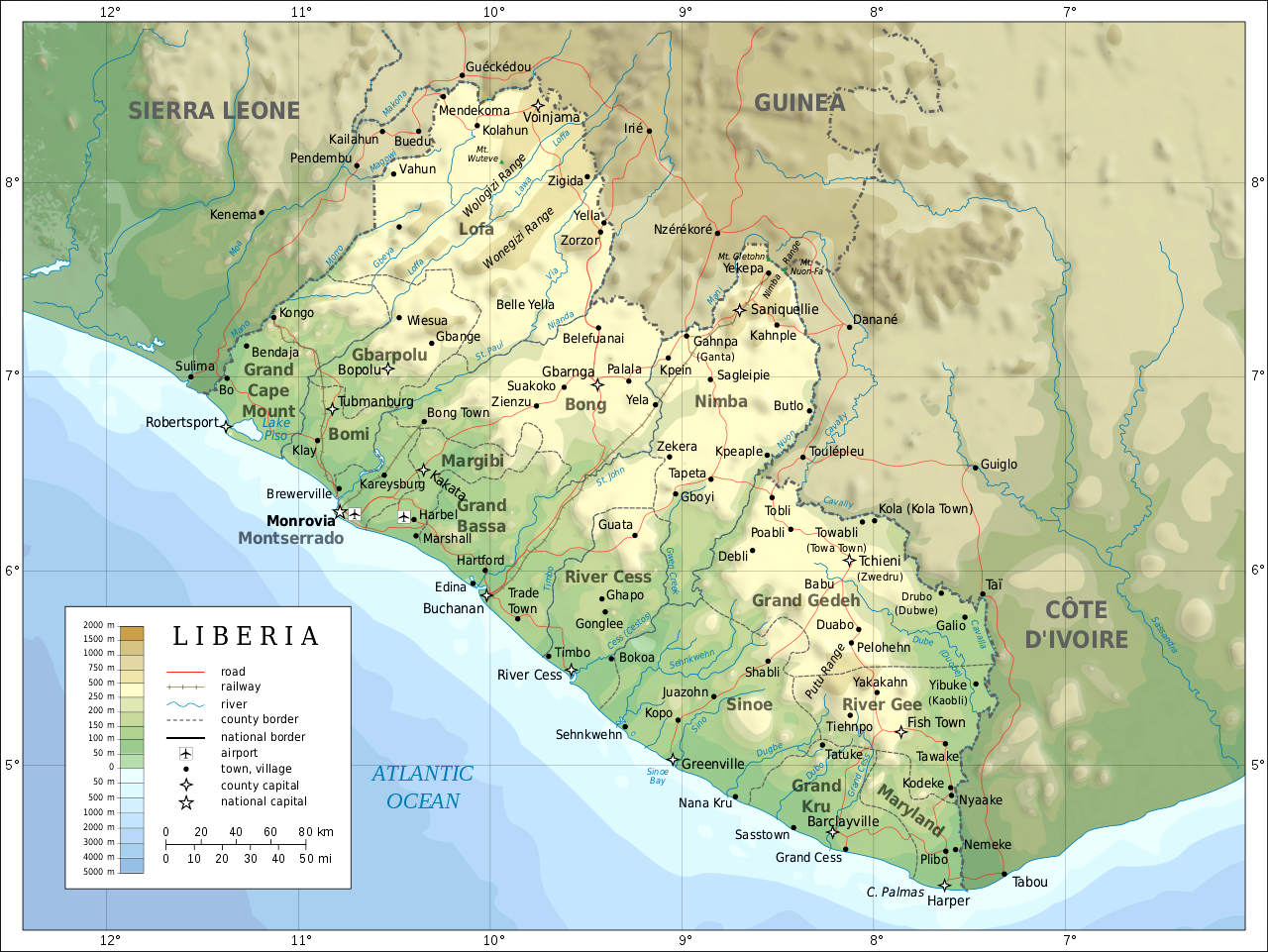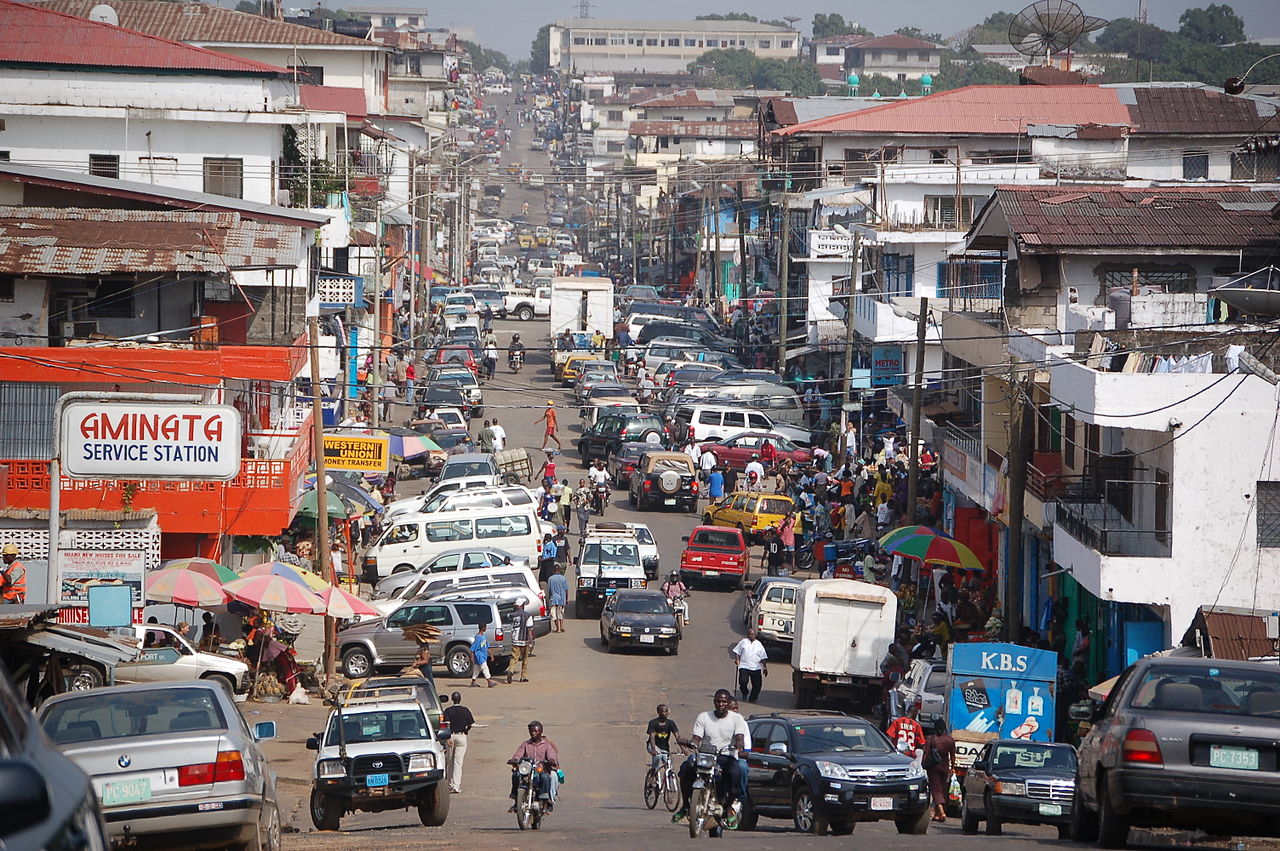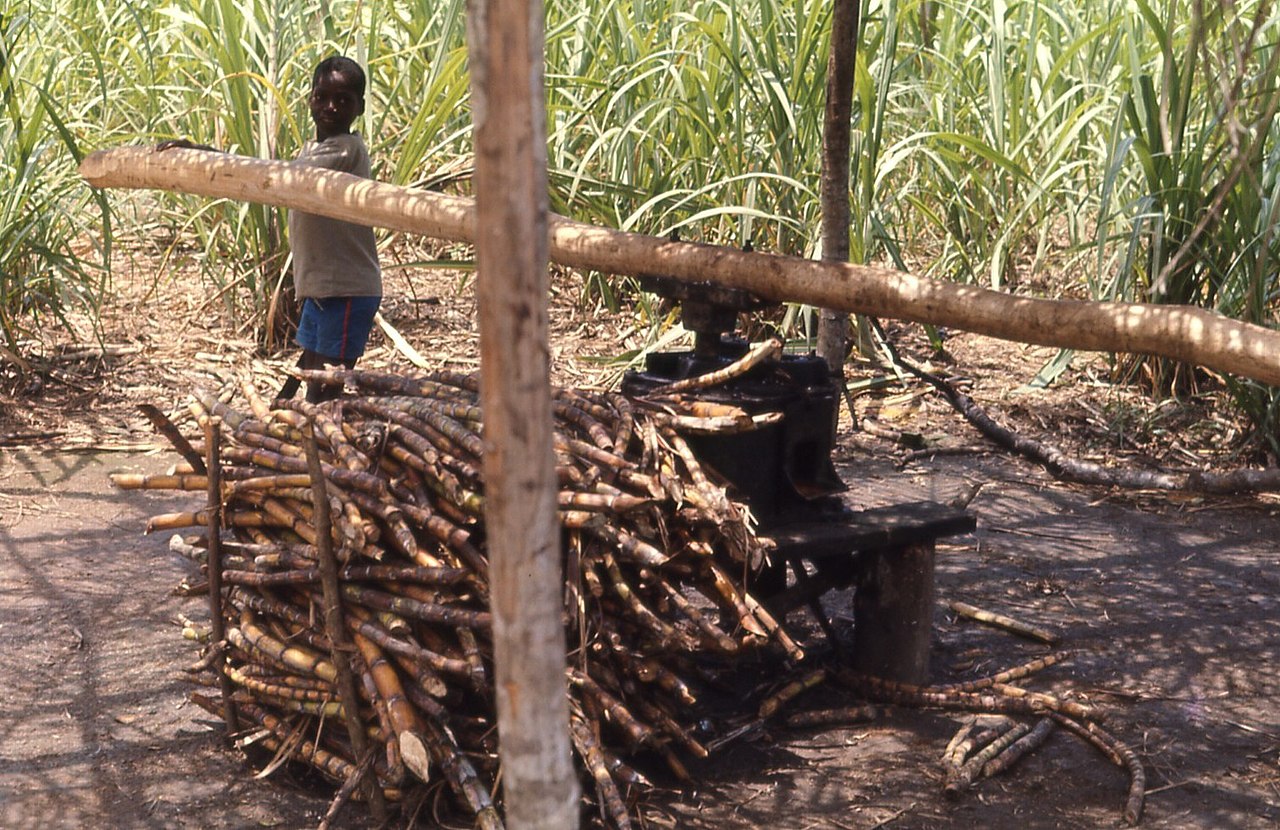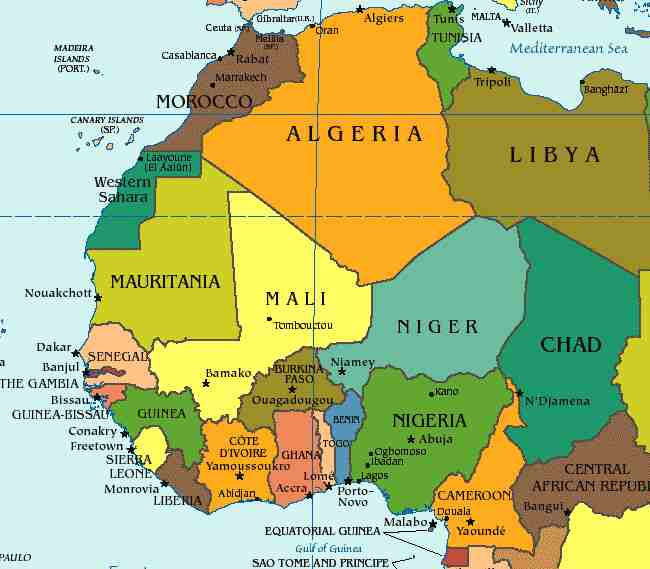|

Liberia, officially the Republic of Liberia, is a country on the West African coast. It is bordered by Sierra Leone to its northwest, Guinea to its north, Ivory Coast to its east, and the
Atlantic Ocean to its south and southwest. It has a population of around five and one-half million and covers an area of 43,000 square miles (111,369 km2). The country's official language is English; however, over 20 indigenous languages are spoken, reflecting the country's ethnic and cultural diversity. The capital and largest city is Monrovia.
Liberia began in the early 19th century as a project of the American Colonization Society (ACS), which believed black people would face better chances for freedom and prosperity in Africa than in the United States. Between 1822 and the outbreak of the
American Civil War in 1861, more than 15,000 freed and free-born African Americans, along with 3,198 Afro-Caribbeans, relocated to Liberia. Gradually developing an Americo-Liberian identity, the settlers carried their culture and tradition with them. Liberia declared independence on July 26, 1847, which the U.S. did not recognize until February 5, 1862.
Liberia was the first African republic to proclaim its independence and is Africa's first and oldest modern republic. Along with Ethiopia, it was one of the two African countries to maintain its sovereignty and independence during the European colonial "Scramble for Africa". During
World War II, Liberia supported the United States war effort against Germany, and in turn received considerable American investment in infrastructure, which aided the country's wealth and development. President William Tubman encouraged economic and political changes that heightened the country's prosperity and international profile; Liberia was a founding member of the League of Nations,
United
Nations, and the Organisation of African Unity.
The Americo-Liberian settlers did not relate well to the indigenous peoples they encountered. Colonial settlements were raided by the Kru and Grebo from their inland chiefdoms. Americo-Liberians formed into a small elite that held disproportionate political power; indigenous Africans were excluded from birthright citizenship in their own land until 1904.
In 1980, political tensions from the rule of William R. Tolbert resulted in a military coup, marking the end of Americo-Liberian rule and the seizure of power of Liberia's first indigenous leader, Samuel Doe. Establishing a dictatorial regime, Doe was assassinated in 1990 in the context of the First Liberian Civil War which ran from 1989 until 1997 with the election of rebel leader Charles Taylor as president. In 1998, the Second Liberian Civil War erupted against his own dictatorship, and Taylor was overthrown by the end of the war in 2003. The two wars resulted in the deaths of 250,000 people (about 8% of the
population) and the displacement of many more, with Liberia's economy shrinking by 90%. A peace agreement in 2003 led to democratic elections in 2005. The country has remained relatively stable since then.

POPULATION
As of the 2017 national census, Liberia was home to 4,694,608 people. Of those, 1,118,241 lived in Montserrado County, the most populous county in the country and home to the capital of Monrovia. The Greater Monrovia District has 970,824 residents. Nimba County is the next most populous county, with 462,026 residents. As revealed in the 2008 census, Monrovia is more than four times more populous than all the county capitals combined.
Prior to the 2008 census, the last census had been taken in 1984 and listed the country's population as 2,101,628. The population of Liberia was 1,016,443 in 1962 and increased to 1,503,368 in 1974. As of 2006, Liberia had the highest population growth rate in the world (4.50% per annum). In 2010 some 43.5% of Liberians were below the age of 15.
ENERGY
Public
electricity services are provided solely by the state-owned Liberia
Electricity Corporation, which operates a small grid almost exclusively in the Greater Monrovia District. The vast majority of electric energy services is provided by small, privately owned generators. At $0.54 per kWh, the cost of electricity in Liberia is among the highest in the world. Total capacity in 2013 was 20 MW, a sharp decline from a peak of 191 MW in 1989 before the wars.
The repair and expansion of the Mount Coffee Hydropower Project, with a maximum capacity of 80 MW, was completed in 2018. Construction of three new heavy fuel oil power plants is expected to boost electrical capacity by 38 MW. In 2013, Liberia began importing power from neighboring Ivory Coast and Guinea through the West African Power Pool.
Liberia has begun exploration for offshore oil; unproven oil reserves may be in excess of one billion barrels. The government divided its offshore waters into 17 blocks and began auctioning off exploration licenses for the blocks in 2004, with further auctions in 2007 and 2009. An additional 13 ultra-deep offshore blocks were demarcated in 2011 and planned for auction. Among the companies to have won licenses are Repsol YPF,
Chevron Corporation, and Woodside
Petroleum.

AGRICULTURE
Agriculture in Liberia is a major sector of the country's economy worth 38.8% of GDP, employing more than 70% of the population and providing a valuable export for one of the world's least developed countries (as defined by the UN). Liberia has a climate favourable to farming, vast forests, and an abundance of
water, yet low yields mean that over half of foodstuffs are imported, with net agricultural trade at -$73.12 million in 2010. This was dismissed as a "misconception" by Liberia's Minister of Agriculture.
The major crops are natural rubber, rice, cassava, bananas and palm oil. Timber is also a major export at $100 million annually, although much of this is the product of unsustainable habitat destruction, with Asian corporations
criticized for their role. Although agricultural activity occurs in most rural locations, it is particularly concentrated in coastal plains (subsistence crops) and tropical forest (cash crops). The sector is very important for women as they are widely employed in it in comparison to the economy as a whole.
ECONOMICS
Following a peak in growth in 1979, the Liberian economy began a steady decline due to economic mismanagement after the 1980 coup. This decline was accelerated by the outbreak of civil war in 1989; GDP was reduced by an estimated 90% between 1989 and 1995, one of the fastest declines in modern history. Upon the end of the war in 2003, GDP growth began to accelerate, reaching 9.4% in 2007. The global financial crisis slowed GDP growth to 4.6% in 2009, though a strengthening agricultural sector led by rubber and timber exports increased growth to 5.1% in 2010 and an expected 7.3% in 2011, making the economy one of the 20 fastest-growing in the world.
Current impediments to growth include a small domestic market, lack of adequate infrastructure, high transportation costs, poor trade links with neighboring countries, and the high dollarization of the economy. Liberia used the United States dollar as its currency from 1943 until 1982 and continues to use the U.S. dollar alongside the Liberian dollar.
Following a decrease in inflation beginning in 2003, inflation spiked in 2008 as a result of worldwide food and energy crises, reaching 17.5% before declining to 7.4% in 2009. Liberia's external debt was estimated in 2006 at approximately $4.5 billion, 800% of GDP. As a result of bilateral, multilateral and commercial debt relief from 2007 to 2010, the country's external debt fell to $222.9 million by 2011.
While official commodity exports declined during the 1990s as many investors fled the civil war, Liberia's wartime economy featured the exploitation of the region's diamond wealth. The country acted as a major trader in Sierra Leonian blood diamonds, exporting over US$300 million (~$516 million in 2023) in diamonds in 1999. This led to a United Nations ban on Liberian diamond exports in 2001, which was lifted in 2007 following Liberia's accession to the Kimberley Process Certification Scheme.
In 2003, additional UN sanctions were placed on Liberian timber exports, which had risen from US$5 million in 1997 to over US$100 million in 2002 and were believed to be funding rebels in Sierra Leone. These sanctions were lifted in 2006. Due in large part to foreign aid and investment inflow following the end of the war, Liberia maintains a large account deficit, which peaked at nearly 60% in 2008. Liberia gained observer status with the World Trade Organization in 2010 and became an official member in 2016.
Liberia has the highest ratio of foreign direct investment to GDP in the world, with US$16 billion (~$23.3 billion in 2023) in investment since 2006. Following Sirleaf's inauguration in 2006, Liberia signed several multi-billion-dollar concession agreements in the iron ore and palm oil industries with numerous multinational corporations, including ArcelorMittal, BHP and Sime Darby. Palm oil companies like Sime Darby (Malaysia) and Golden Veroleum (USA) have been accused of destroying livelihoods and displacing local communities, enabled by government concessions. Since 1926 Firestone has operated the world's largest rubber plantation in Harbel, Margibi County. As of 2015, it had more than 8,000 mostly Liberian employees, making it the country's largest private employer.
FLAG OF CONVENIENCE
Due to its status as a flag of convenience, Liberia has the second-largest maritime registry in the world behind Panama. It has 3,500 vessels registered under its flag, accounting for 11% of ships worldwide.

Map
of West Africa

DOOMSDAY
OPERATION GRAND SLAM -
Disillusioned extremists in Iran,
North Korea and Russia,
have grown impatient waiting for their leaders to act decisively, having
watched the Ukraine debacle
of Vladimir Putin rebound to weaken
their CRINK
axis members. This despite Hamas launching against Israel and
Houthi attacks on the Red
Sea. All that had the effect of waking the sleeping giant: NATO.
They
hatch a plot to kidnap top politicians from the west to create confusion,
as a prelude to an all out cyber
nuclear first and second strike, having first stockpiled sufficient gold
and weapons reserves, and fallout bunkers for their cells, to be able to
stage a second wave of conventional attacks, to in effect, take over the
world after the nuclear holocaust they
have engineered. Including assassinating their jaded leaders: Xi
Jinping; Vladimir
Putin, Iranian Grand Ayatollah, Ali
Khamenei, and Kim
Jong Un, supreme leader of communist North
Korea.
External
links
500ml
PET bottle
|
Adelaide
Aden
- Yemen
Afghanistan
Africa
Alaska
Albania
Algeria
Amazon
Rainforest
Amsterdam
Antarctic
Arctic
North Pole
Argentina
Asia
Athens
Atlantis
- Plato's Lost City
Australia
Austria
Aztecs
- Mexico
Baghdad
Bahamas
Bahrain
Bangladesh
Barbados
Beachy
Head, England
Belgium
Benin
Berlin
Bermuda
Black
Rock Desert
Bohemia
Bolivia Bonneville
Utah History
Bonneville,
Utah, USA
Brazil
Brighton
- West Pier
British
Columbia
Buckingham
Palace
Bulgaria
Burkina
Faso
Burma
California
Canada
Canary
Islands
Cape
Horn
Cape
Verde
Cape
York - Au
Caribbean
Cayman
Islands
Central
Africa
Chichester
Harbour
Chile
China
Columbo
- Sri Lanka
Columbia
Corfu
Cowes,
Isle of Wight
Croatia
Crooked
Island, Bahamas
Cuba
Cyprus
Czechoslovakia
Darwin
- Australia
Daytona
Beach
Denmark
Eastbounre
Pier, England
Earthquakes
Ecuador
Egypt
Eindhoven Estonia
Equator
Europe
Falkland
Islands
Falmouth,
Cornwall
Fiji
Finland
France
Galapagos
Islands
Geography
Links
Geography
Mountains
Geography
Records
Geography
Resources
Geography
Statistics
|
Germany
Ghana
Gibraltar
- Links
Greece
Greenland
Guinea
Guinea
Bissau
Hawaii
Holland
the Nertherlands
Hollywood,
California, LA
Hong
Kong
Hungary
Hurricanes
Iceland
India
Indonesia
Links
Iran
Iraq
Ireland
Isle
of Man
Isle
of Wight
- The
Needles
Israel
Italy
Ivory
Coast
Jakarta
- Java
Japan
Johannesburg
Jordan
Kent,
England
Kenya
Korea
Kuwait
Kyoto
Lanzarote,
Gran Canaria
Las
Vegas
Lebanon
Liberia
Libya
Liechtenstein
Life
on Earth
Lithuania
London
- Big
Ben
London
Eye
London
Houses
Parliament
London
- Buckingham
Palace
London
- Old
Bailey
London
- Overview
London
- The City
London
- Tower Bridge
London
- Trafalgar
Square
Luxembourg
Madame
Tussauds
Malaysia
Mali
Malta
Marshal
Islands
Mauritania
Maya
Empire -
Central America
Melbourne,
Australia
Middle
East
Melbourne,
Australia
Mexico
Monaco
Morocco
Mountains
Mumbai
Naples-
Italy
National
Geographic
Nepal
New
York
New
Zealand
Niger
Nigeria
North
Africa
Norway
Nova
Scotia
Oceans
and Seas
Oman
Pakistan
Palermo
- Sicily
Palestine
Palma
- Malorca
|
Panama
Canal - Links
Paris
Pendine
Sands
Peru
Philippines
Pisa,
Leaning Tower
Planet
Earth
Poland
Port
Moresby - PNG
Port
Said - Egypt
Portugal
Puerto
Rico
Qatar
Quebec
Rio
de Janeiro
Romania
Rome
Russia
Salt
Lake City
Samoa
Saudi
Arabia
Scandanavia
Scotland
Senegal
Siera
Leone
Singapore
Solomon
Islands
Somalia
South
Africa
South
America
Southampton
Spain
- Espana
Sri
Lanka - Links
Stonehenge
Sudan
Suez
Canal
Sundancer
Holiday Resort
Sussex,
England Index
Sweden
Switzerland
Sydney,
Australia
Syria
Tahiti
- Polynesia
- Links
Tahitian
- Men & Women Customs
Taiwan
Thailand
The
Gambia
Togo
Tokyo,
Japan
Tonga
- Polynesia
Toronto
Trinidad
- Lesser Antilles
Trinidad
and Tobago
Tsunami
Tunbridge
Wells, England
Tunisia
Turkey
Tuvalu
Islands
UAE
- United Arab Emirates
UK
Statistics
Ukraine
United
Kingdom
United
Kingdom -
Gov
USA
Uruguay
Vanuatu
Islands
Vatican
City
Venezuela
Venice
Vienna
Vietnam
Volcanoes
Volendam
Wales
Washington
D.C.
WAYN
Where Are You Now
Wealden
iron industry
Wendover
West
Africa
World
Peace Supporters
Yemen
Yugoslavia
Zurich
|

Solar
Cola drinkers care about planet
earth
..
Thirst for Life

(330ml
Planet Earth can)
|






